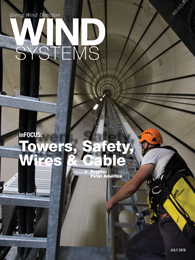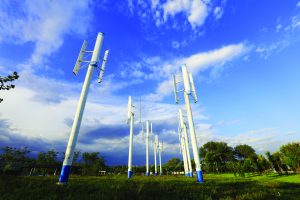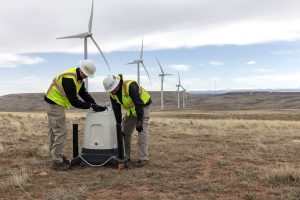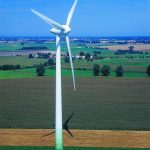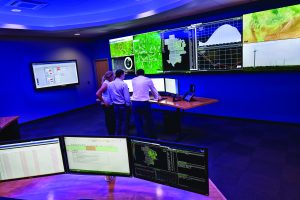What can be 198 feet tall but be overlooked as easily as the infamous missing 10-millimeter socket?
While meteorological (met) towers are a critical part of the initial planning and assessment for energy production, there is a strong likelihood that your met tower is an unfamiliar asset and may in fact need a little TLC.
Part of the mystery surrounding the met tower could be attributed to the remote location of the met tower on the wind farm. Another possible contributor to the mystery of the met tower could be due to the relationship it has to the “money makers” — wind turbines that generate the power that creates the revenue. Another possible contributor to the mystery of the met tower could be the fact that different standards from differing agencies can apply to the mysterious met tower: FAA Regulations and Advisory Circulars, ASME Standards, OSHA requirements, ANSI Z359 for fall protection standards, tower standards (TIA/EIA 222), and IEC 61400-12-1 address the individual systems of the met tower. It can all be overwhelming to the typical wind-site manager or designee, but with a little bit of planning and communication, the mystery can be removed.
And The Survey Says
As a norm, wind-site managers are tasked with an enormity of responsibilities and reports. Safety, generation requirements, environmental compliance, regulatory compliance, staffing, training, conference calls, and the weekly Tidy Friday can all push the needs of the met tower to somewhere just behind weekly vehicle inspections. In other words, the silent sentinels of data acquisition can often be overlooked.
An informal survey of selected U.S. wind farms showed that many site managers were not familiar with the needs, operational status, or records regarding their site met towers. Site leadership turnover, the lack of “tribal knowledge,” and all of the other duties that demand the time and attention of site leaders may attribute to this gap.
Interestingly, nearly 29 percent of those who responded to the survey stated that they had “inherited the met tower, sensors, and data loggers” and were not familiar with what type of data logger was in the met tower, and 25 percent of the respondents stated that the only time their team visits the met towers is when “something was wrong.”
Waiting until there is something wrong with your met tower can be a costly proposition. The time and cost associated with mobilizing a team, procuring materials, and notifying regulatory agencies of a failure in your met tower can be a huge investment. The safety considerations of a failed system can place your team and outside staff at an unnecessary risk. A failed met tower can create a lot of attention from land owners, regulatory agencies, press, and upper management — these items are not what you want for your week.
Periodic tower inspections and maintenance can help prevent costly repairs and help ensure accurate and reliable wind data. The documented inspection of all monitoring equipment, met tower structure, cabling, and grounding systems prove to be very valuable for the safe, reliable operations at your site. While tower data should always be monitored for irregularities that may indicate potential sensor or equipment failures, documenting maintenance and inspection records will help protect your wind-assessment investment and provide a historical continuity that can be extremely valuable when needed. At a minimum — a periodic, scheduled inspection and preventative maintenance regime with reliable documentation is regarded as best practice by owners, operators, and maintenance providers in this sector.
If It Isn’t Documented, It Didn’t Happen
Where do you start to establish a consistent, documented inspection of the asset? What template or guideline can you use to ensure that the critical components of your met tower have been inspected and have accurately recorded that information?
A number of companies have responded to this specific need for the inspection and reporting requirements of your met tower. Sioux Falls Tower & Communication has been recognized as a great resource for the scheduled services and inspection of your system. Craig Snyder and his team at Sioux Falls can provide a thorough 145-point inspection of all components of your tower that includes a detailed report for your records. They provide a complete inspection of met tower foundation, (or base plate), grounding, guy wires, fasteners (bolts), safety markings, booms, sensors, and cabling and lighting. A systematic report is physically generated and provided to the site detailing specifications and images of your tower, making critical information accessible and useful when needed.
How often is this assessment to be conducted? FAA guidelines require that the lights be inspected every 24 months and that “lamps should be replaced after being in operation for approximately 75 percent of their rated life or immediately upon failure. Flashtubes in a light unit should be replaced immediately upon failure, when the peak effective intensity falls below specification limits or when the fixture begins skipping flashes, or at the manufacturer’s recommended intervals.” (FAA Advisory Circular AC 70 7460-1L).
“Met towers are usually very durable structures,” Snyder said. “Many owners are following the best practice by conducting a physical inspection of the electronic components annually and scheduling major maintenance at three-year intervals for guyed towers and a five-year cycle for self-supporting (lattice) towers, according to TIA 222.”
Scheduling met tower service inspections will help protect your wind assessment investment. A regular inspection schedule of all monitoring equipment, met tower, cabling, and power supplies can prevent lost data and save you valuable time and money. The days of reacting to a met tower “emergency” by sending your best wind-turbine techs out to get the system back on line is not the best option available to you as a site leader. The met tower has a number of systems and safety concerns that the wind technician is not equipped nor trained to effectively and safely navigate. Let the technicians keep the turbines spinning; leave the met towers to the specialists.
Getting To The Heart Of The Matter
Your wind-resource data is the key to your success. It captures and records the information of your availability and provides compliance information for offtakers. Many of our customers ask: “How often do we need to collect our data?” The answer: How much data can you afford to lose? If your data is that important — and it is — then how often do you need to calibrate your sensors and your data loggers?
Most sensors are calibrated annually or at least every two years — and what about your data logger? Again, the survey from the field revealed a large discrepancy in calibration requirements for the heart of your data system. Nearly 43 percent of site managers were not aware of datalogger calibration schedules.
Dataloggers are the heart of your wind resource assessment system and need to be accurate and dependable under extreme conditions. While some datalogger manufacturers recommend a two-year calibration scheme, Campbell Scientific recommends a three-year cycle for calibration of their dataloggers.
A recent study conducted and verified by a third party revealed that over a five-year period, there was virtually no “data drift” in their Campbell Scientific datalogger. The take away from this report is that you should not have to worry about measurement uncertainty. Make sure your datalogger has been tested at the manufacturer and has the calibration and, more importantly, that the data of the actual test measurements over temperature are shared with you. Follow your manufacturer recommendation and observe best practice for calibration of your datalogger.
The Sky is the Limit
The days of knee-jerk responses to get your met tower fixed with significant resources do not need to be the norm for your wind farm. With a systematic approach, solid equipment, and good relationships with key players, you can keep your wind-resource data consistent and secure. Scheduled inspections, periodic maintenances, and a standardized documentation plan can keep your met tower down time and lead times manageable. The tower system used as the standard for your wind resources can continue to operate efficiently and provide you reliable, accurate data.
















